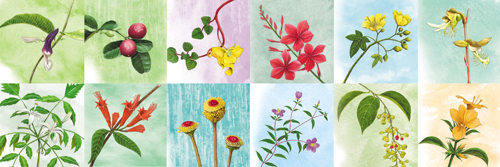SLT’s 2014 calendar focuses on medicinal plants in Sri Lanka
View(s):Sri Lanka Telecom (SLT) has focused on medicinal plants in Sri Lanka in its latest 2014 calendar.
The calendar has drawings of 12 varieties of medicinal plants that have been widely used for medicinal purposes for over thousands of years.
“SLT has been continuously promoting and advocating the preservation of the rich heritage of our country for the benefit of future generations. One of the ways in which this is being done is via the CSR theme of “Preserving heritage for tomorrow”. The company produces calendars and complementary items, and has been carrying out a wide range of initiatives with the aim of educating the public, especially the younger generation on the importance of conserving our heritage for tomorrow since 2003,” a company statement said.
With the main theme “preserving heritage for tomorrow”, the company produces calendars and complementary items to encompass diverse fields such as nature, arts and culture each year. Some popular past themes include: Endemic birds of Sri Lanka (2003), Endemic orchids of Sri Lanka (2005), Kolam masks of Sri Lanka (2006), Endemic fresh water fish of Sri Lanka (2007), Gok Art (2008), Endemic Butterflies of Sri Lanka (2009), Heritage of Sinharaja (bio-diversity) (2010), Re-discovering hidden heritage (2011), Drums of Sri Lanka (2012) and Rush and Reed Craft of Sri Lanka (2013).
Through art work the 2014 calendar depicts 12 selected medicinal plants found in Sri Lanka as well as information on their habitat, general features, characteristics and therapeutic uses. Some of these plants are endemic to Sri Lanka while others have been brought into the country and cultivated. The calendar contains a wealth of information that is of great educational value and interest for a wide audience that includes the general public, collectors and students. SLT said the resource person for the 2014 calendar was Dr. Pathirage Kamal Perera who has specialized in Pharmacology, Immune Medicine and Clinical products Development and is also a Senior Lecturer/Researcher at the Institute of Indigenous Medicine, University of Colombo, and the Head of Department of Allied Sciences. The drawings for the calendar were done by Parami Vidayarathane, while design and production was undertaken by an in-house team at SLT.
“Majority of the medicinal plants featured in the calendar are used for the preparation of Ayurveda medicines. Although these plants have been used for medicinal purposes for over a thousand years, with the spread of western medicine, knowledge on these plants and their uses have not reached the younger generation of today,” the statement said.
It said lack of knowledge on some of these medicinal plants such as Wanaraja and Duhudu which are in the SLT calendar have brought them to the verge of extinction and are today red-listed by the IUCN.
The SLT statement also had a word of caution: “Special Attention: Please consult a qualified Ayurvedic physician prior to using any of the plants depicted in the SLT Calendar 2014 for medicinal purposes”.


